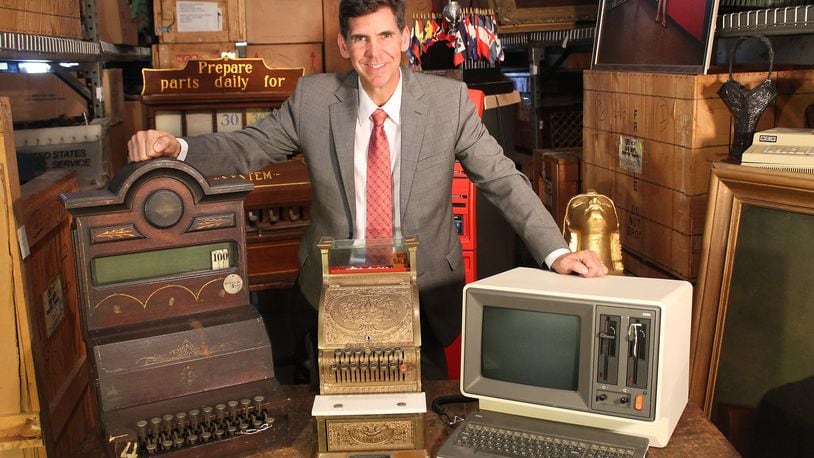NCR has one of the most impressive corporate collections in the entire nation. Comprised of 3 million artifacts valued at millions of dollars, the collection chronicles the history of NCR, the Dayton region, and helps tell the story of business internationally.
NCR recently gifted its entire collection to Dayton History and Carillon Historical Park; fittingly, the latter organization was established by NCR’s third CEO Col. Edward A. Deeds.
“This is a tremendous gift from NCR to Dayton History and the Dayton region,” says Brady Kress, president and CEO, Dayton History. “The NCR archive contains one of the region’s largest single collections of its history, documenting thousands of families and multiple generations of Daytonians. The impact NCR had on the growth of the region is immeasurable, and the archive contains and tells those stories.”
With NCR’s gift, Dayton History is poised to expand their exhibits and invest in more extensive educational programming.
“Gifting our historical collection to Dayton History is a celebration of the community’s contributions to NCR and our contributions to the city of Dayton, and ensures that generations to come will have access to pieces of that history,” says NCR Foundation Lead Yvonne Whitaker.
>> 12 facts about Dayton history you need to know
Here are 7 highlights from the NCR collection:
Credit: Lisa Powell
Credit: Lisa Powell
1. Wright Brothers artifacts
When Orville Wright died on Jan. 30, 1948, Hawthorn Hill was purchased by NCR for use as a corporate guest house. Col. Edward A. Deeds, third CEO of NCR and founder of Carillon Park, was close friends with Orville, and led the purchase of his famous Colonial Revival home for $60,000. For an additional $15,000, Deeds and NCR acquired all of Hawthorn Hill’s furnishings. Nearly 70 years after he first purchased Hawthorn Hill’s artifacts, the collection is now under the care of Carillon Park, the organization Deeds established.
>> 5 cool facts about Hawthorn Hill
Credit: Courtesy Special Collections and Archive, Wright State University
Credit: Courtesy Special Collections and Archive, Wright State University
2. Over 1.3 million images
Rivaling some of the finest in the world, the NCR photo collection is a treasure trove of breathtaking image topics ranging from the city of Dayton to international business. The collection is comprised of over 1.3 million images and landmarks, all of which are true works of art. Over 40,000 images are online at daytonhistory.org.
>> PHOTOS: Check out these historical images from the NCR collection
3. Over a century of advertising art
NCR founder John H. Patterson’s innovative sales and marketing techniques made a global impact on the business world, and it made Patterson the “Father of American Salesmanship.” Patterson often began dialogues with NCR employees and customers through the use of advertising circulars, direct-mail letters, selling handbooks, employee newspapers, and special pamphlets. Over a century of NCR advertising art is included in the collection.
>> 6 things you didn’t know about John Patterson
4. The 1938 Electronic Accumulator
Dayton inventor Joseph Desch is famous for his groundbreaking work on U.S. Navy bombes — the machines that broke Nazi German four-rotor enigma naval codes and brought an early end to World War II. Desch also worked as director of the NCR Electrical Research Department, and alongside Robert Mumma, he built the electronic accumulator in 1938. Believed to be the world’s first vacuum-tube-driven computing device, the electronic accumulator primed the world for true first-generation computers.
The 1938 Electronic Accumulator is on display at Carillon Historical Park.
5. NCR 304
At a time when computers were primarily viewed as scientific devices, NCR set about designing a computer with business applications in mind. In 1957, the company debuted the world’s first solid-state business computer: the NCR 304.
First purchased by the U.S. Marine Corps, and installed at Camp Pendleton, Calif., the device was so successful in helping maintain the Marines’ personnel and equipment records that they ordered three more systems. Macy’s department store and Sumitomo bank in Osaka, Japan, also employed the 304.
The console for the 304 is on display at Carillon Historical Park.
6. Scientific and Computing Milestones
Tens of thousands of engineering notebooks, blueprints, and laboratory devices chronicle the amazing development of critical components used by millions of people worldwide, including early computers, signature capture, microencapsulation, LCDs, thermal printing and magnetic strip technologies.
Credit: Allegra Czerwinski
Credit: Allegra Czerwinski
7. 1,000 Machines
The elaborate display of NCR cash registers at Carillon Historical Park’s Heritage Center of Manufacturing and Entrepreneurship is only a small smattering of the collection. From early wooden models to stunning brass prototypes to heavy payroll and banking systems, these rare machines are true works of art.
Included in the collection is the Class 1000, the first electrically operated cash register. Charles Kettering was tasked with electrifying the cash register, and he applied similar technology in inventing the automobile self-starter. The oldest register in the collection is the Ritty Dial, patented in 1879 by Daytonian James Ritty.
About the Author
